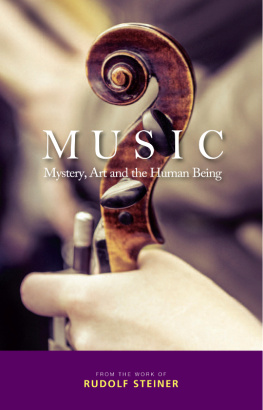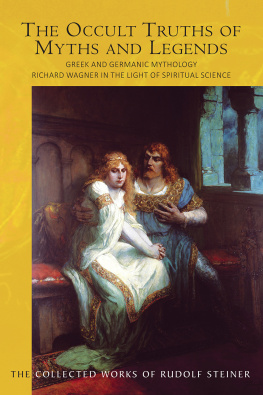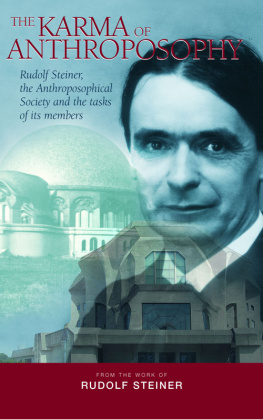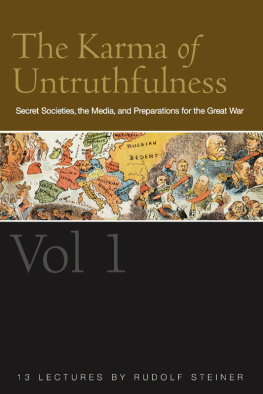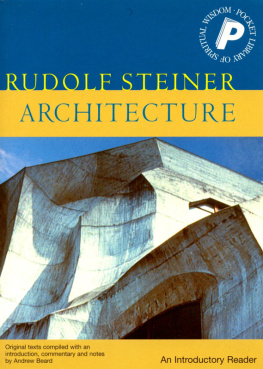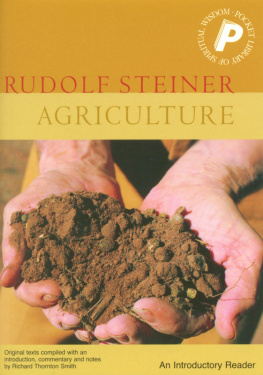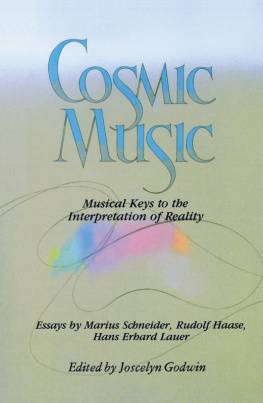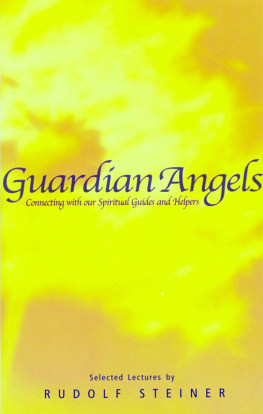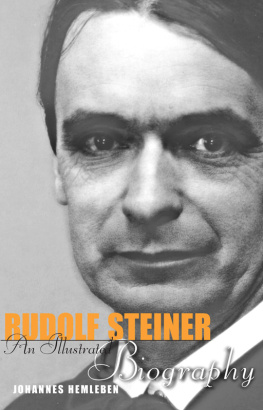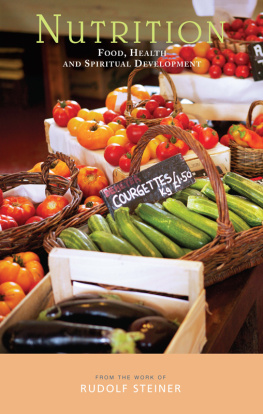Rudolf Steiner - Music: Mystery, Art and the Human Being
Here you can read online Rudolf Steiner - Music: Mystery, Art and the Human Being full text of the book (entire story) in english for free. Download pdf and epub, get meaning, cover and reviews about this ebook. year: 2016, publisher: Rudolf Steiner Press, genre: Religion. Description of the work, (preface) as well as reviews are available. Best literature library LitArk.com created for fans of good reading and offers a wide selection of genres:
Romance novel
Science fiction
Adventure
Detective
Science
History
Home and family
Prose
Art
Politics
Computer
Non-fiction
Religion
Business
Children
Humor
Choose a favorite category and find really read worthwhile books. Enjoy immersion in the world of imagination, feel the emotions of the characters or learn something new for yourself, make an fascinating discovery.
- Book:Music: Mystery, Art and the Human Being
- Author:
- Publisher:Rudolf Steiner Press
- Genre:
- Year:2016
- Rating:4 / 5
- Favourites:Add to favourites
- Your mark:
- 80
- 1
- 2
- 3
- 4
- 5
Music: Mystery, Art and the Human Being: summary, description and annotation
We offer to read an annotation, description, summary or preface (depends on what the author of the book "Music: Mystery, Art and the Human Being" wrote himself). If you haven't found the necessary information about the book — write in the comments, we will try to find it.
In this unique anthology of texts, with a commentary and notes by Michael Kurtz, Steiner describes the realm of the spiritually-resonating harmonies of the spheres and our intrinsic connection to this cosmic music. He also explores the phenomenon of musical listening and experience, as well as Goethes approach to music.
Music: Mystery, Art and the Human Being — read online for free the complete book (whole text) full work
Below is the text of the book, divided by pages. System saving the place of the last page read, allows you to conveniently read the book "Music: Mystery, Art and the Human Being" online for free, without having to search again every time where you left off. Put a bookmark, and you can go to the page where you finished reading at any time.
Font size:
Interval:
Bookmark:

RUDOLF STEINER (18611925) called his spiritual philosophy anthroposophy, meaning wisdom of the human being. As a highly developed seer, he based his work on direct knowledge and perception of spiritual dimensions. He initiated a modern and universal science of spirit, accessible to anyone willing to exercise clear and unprejudiced thinking.
From his spiritual investigations Steiner provided suggestions for the renewal of many activities, including education (both general and special), agriculture, medicine, economics, architecture, science, philosophy, religion and the arts. Today there are thousands of schools, clinics, farms and other organizations involved in practical work based on his principles. His many published works feature his research into the spiritual nature of the human being, the evolution of the world and humanity, and methods of personal development. Steiner wrote some 30 books and delivered over 6000 lectures across Europe. In 1924 he founded the General Anthroposophical Society, which today has branches throughout the world.
MUSIC
Mystery, Art and the Human Being
RUDOLF STEINER
Edited and Introduced by Michael Kurtz
Translated from German by Matthew Barton
RUDOLF STEINER PRESS
Rudolf Steiner Press
Hillside House, The Square
Forest Row, RH18 5ES
www.rudolfsteinerpress.com
Published by Rudolf Steiner Press 2016
Originally published in German under the title Die Welt der Musik by Rudolf Steiner Verlag, Basel, in 2012
Rudolf Steiner Verlag, Basel, 2012
This translation Rudolf Steiner Press 2016
All rights reserved. Apart from any fair dealing for the purpose of private study, research, criticism or review, as permitted under the Copyright, Designs and Patents Act, 1988, no part of this publication may be reproduced, stored in a retrieval system, or transmitted in any form or by any means, electronic, electrical, chemical, mechanical, optical, photocopying, recording or otherwise, without the prior written permission of the copyright owner. Inquiries should be addressed to the Publishers
A catalogue record for this book is available from the British Library
Print book ISBN: 978 1 85584 526 8
Ebook ISBN: 978 1 85584 481 0
Cover by Morgan Creative. Cover image Frog-travel
Typeset by DP Photosetting, Neath, West Glamorgan
CONTENTS
INTRODUCTION
The true nature of music, the spiritual element in music, is found between the tones, lies in the intervals as an inaudible quality.
From the ancient, sophisticated cultures of the East through Greek antiquity to medieval Christianity in Europe, music has always played a natural and clearly defined role in many forms of ritual, worship and education. In past eras people still felt there to be concord between music, humanity and the world of stars, which was regarded as the dwelling place of the gods. But that time has passed. Nowadays our view of music has sundered itself from these general religious outlooks, and the classical modes of, say, Bach, Beethoven or Bruckner, have become just one idiom amongst many other possibilities. Today every composer has their own distinct view of music.
What is the reason for this change of outlook? A signature of the modern age is that people release themselves from traditions and prescribed rules, instead taking autonomous, individual decisions and actions. In a questionnaire Rudolf Steiner once completed in Weimar in 1893, he coined the phrase The free human being in place of God as his personal motto. This emancipatory process is still in its birth pangs, but is certainly a feature of daily contemporary life.
Born three years after the end of the Second World War, I have always felt an interest in the cultural atmosphere of those post-war years. It was a time of reflection, of sober assessment after the horrors of the war, and in the arts led to a radical new beginning but at the same time also to an imaginatively impoverished material art. At the time two small works threw open the doors to literally radical new developments; going to the very root of things they sought to start again from zero. These were two experiments that made history by helping to dismantle the final vestiges of tradition. In Cologne, at the Electronic Studio, Karlheinz Stockhausen composed his Study I in 1953, himself creating its electronically generated tones and tonal qualities (pitch, volume, duration) in strictly rational patterns. This musical homunculus opened up the possibility of a world of all conceivable tones and noises. This absolute control of acoustic tone was diametrically opposed to the Zen Buddhist gesture of complete relinquishment, which John Cage created in his silent piece, 4 33. The time structure of the work's three movements was determined with the aid of the Chinese I Ching oracle. But the composer here makes no indication of notes since the music consists of any accidental noises that can be heard during these 4 minutes and 33 seconds.
This raises questions, such as: What is music? Is anything we hear music? Is everything my ear receives already music? And finally: Where do we stand as human beings in all these matters? In recent decades there has been a great deal of research to show that this art form, specifically, has a profound effect on the human being.
In the birth pangs of these new developments, Rudolf Steiner's reflections on the world of music, as this compilation shows, can offer us new perspectives and reveal deeper strata of experience. The quotation aboveThe true nature of music, the spiritual element in music, is found between the tones, lies in the intervals as an inaudible quality - may seem too intangible for some. Rudolf Steiner regards the essence of music as something spiritual, inaudible to the senses; and the world of tones, borne on the vibrations of air, in some sense already as a kind of banishment from this loftier condition.
Thus the seven chapters of this collection of texts start with the intrinsic world of music as Rudolf Steiner sees it: the realm of the spiritually resonating harmonies of the spheres. It is here that we dwell during sleep and in the period between death and rebirth. The astonishing potencies of this music of the spheres appear, for instance, in the chemistry of earthly substances or in the growth and developing morphology of plants.
Chapter 2 identifies how this music of the spheres is connected with humans, our inner and outer form being the outcome of this world, as Rudolf Steiner describes in many diverse ways. Following this, we explore the art of music itself in relation to this realm: the creative shaping of tones by human beings. The works of great composers can give expression to memories or echoes of these harmonies of the spheres. From 1915, Rudolf Steiner offered stimulus for a new kind of composition drawn from a deepened experience of the single tone. Independently of Steiner, various composers since then have been preoccupied with the phenomenon of the individual tonefor instance, the Italian Giancinto Scelsi, French composers of the Spectral school such as Grard Grisey and Tristan Murail, joined more recently by Wolfgang von Schweinitz. These compositions and experiments are largely concerned with the acoustic spectrum of a tone, whereas Steiner was engaging with the spiritual, moral realm of tone experience.
For Rudolf Steiner, the essence of music consists of the intervals and their qualities, as chapter 4 reveals. These qualities are the inwardly sensed movements between tones. Besides this, the intervals also have their significance as, if you like, a musical embodiment of human evolution: from the interval of the ninth in Lemuria through the seventh in Atlantis to the third since the beginning of the modern era. Thus they express the distinctive soul moods inherent in the development of human consciousness.
Next pageFont size:
Interval:
Bookmark:
Similar books «Music: Mystery, Art and the Human Being»
Look at similar books to Music: Mystery, Art and the Human Being. We have selected literature similar in name and meaning in the hope of providing readers with more options to find new, interesting, not yet read works.
Discussion, reviews of the book Music: Mystery, Art and the Human Being and just readers' own opinions. Leave your comments, write what you think about the work, its meaning or the main characters. Specify what exactly you liked and what you didn't like, and why you think so.

